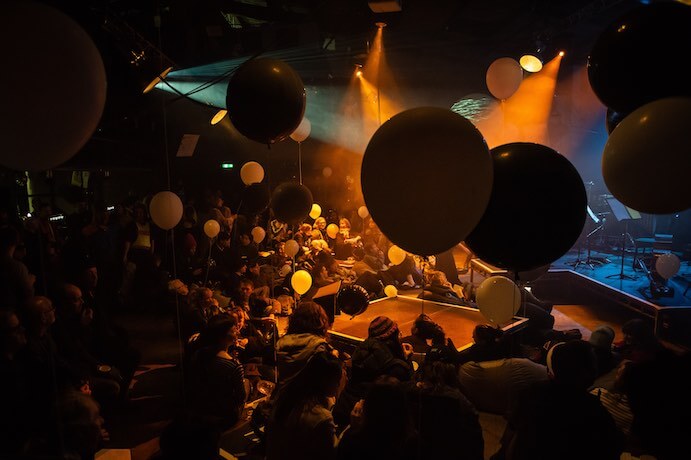On Nov. 15 I went to a nightclub in east London — OK, it was 7 p.m. and the Colour Factory in Hackney Wick had been booked for a London Sinfonietta collaboration, but the raw space is a long way from their usual concert hall performance venues. There was haze, there were balloons, there were beanbags, and there were overpriced cocktails.
Founded in 1968, the Sinfonietta is a well-known fixture of the British contemporary music scene and indeed has acted as a model for similar ensembles, such as Ensemble Intercontemporain in Paris. This event was part of the Sinfonietta’s “Writing the Future” scheme, which is aimed at “artists from a non-classical background such as sound artists and improvising musicians, as well as music creators from historically under-represented groups or communities such as artists representing the Global Majority, LGBTQ+ communities, and those who identify as disabled.” The selected artists write for the ensemble, who are seeking new ideas for their chamber music formation.
Their chosen collaborator at the Colour Factory was composer/performer Nwando Ebizie, who has released multimedia work featuring vocals, beats, spectacular costumes and makeup, and kaleidoscopic motion graphics. For Fall and then Rise on a Soft Winter’s Morning she wrote and narrated her own text, drawing on influences ranging from Haitian Vodou mythology to Jungian theory to Angela Carter’s novel Nights at the Circus.
Nwando Ebizie — Photo by Monika S. Jakubowska
Ebizie’s overarching aim was to give d/Deaf audiences an equally fulfilling experience as hearing audiences; she cares deeply about accessibility because of her own experience as a neurodivergent and disabled creator. Having worked before with d/Deaf viewers, she wanted her new work to include many different sensory elements, including vibration and engagement through touch. This was an event that truly engaged all the senses. Of course, any individual audience member can only experience the work from their own perspective, and my perspective is that of a hearing person.
On paper this perhaps sounds worthy. However, the event was anything but a tick-box exercise: it packed a lot of emotional and sensory variety into a short period. There were plinths to sit on that sporadically vibrated to the music. Ebizie was a striking performer wearing a magnificent silver headdress; she was a guide and narrator who was relatable and engaging. The three main sections of her piece were accompanied by a harpist (Lizzie Bass), clarinetist (Mark van de Wiel), double bassist (Phoebe Clarke) and two percussionists (Joe Richards and Oliver Lowe) from the London Sinfonietta conducted by Chloe Rooke, and three interludes focused on recorded sound. We were invited to perform various actions — sharing popcorn tubs with our neighbours, playing with the balloons — during the interludes, which acted as points of relaxation from the emotional narrative.
Ebizie took us on a journey that culminated in a dance of death that became more frenzied until, in her words, “there is nothing left.” Her narration was interpreted by a signer, and by an expressive dancer and d/Deaf performance artist, Chisato Minamimura. Ebizie’s well-paced music focused on vibrant, almost tactile sounds: a bowed vibraphone, a rubbed drum and gong, an evocative double bass melodic fragment. One of the most memorable moments was van der Wiel’s first entry, with a white balloon stretched over the bell of his clarinet: he breathed into the instrument, struggling to produce a sound while the balloon inflated and deflated. This imaginative gesture immediately highlighted the emotional breadth of the work — human struggle coexisting with comedy in an unexpected yet relatable manner. The second section, “Dream,” most effectively conveyed the intensity of the narrative, Ebizie’s words underpinned by a thudding, rubbed drum, melodic double bass, and a klezmer-infused clarinet line.
Chisato Minamimura — Photo by Monika S. Jakubowska
How many concerts are genuinely multisensory experiences? While many attenders were London Sinfonietta regulars travelling to an unfamiliar venue, the event also attracted a diverse crowd and the production enabled everyone to engage in their own way. At the end of the show, a blind audience member was led to the harp and was encouraged to touch the frame while harpist Lizzie Bass played her instrument. Ebizie created an event that was moving, immersive, participatory and genuinely engaging for all.
Like many concert-giving organisations today, the London Sinfonietta aims to be more inclusive and more representative of the diverse population of the U.K.’s capital. At the same time, on their website they promote recent recordings of music primarily written by male composers. I have no doubt of their sincerity and good intentions, but I would also like to see the diversity and imagination of their “Writing the Future” artists infused in their regular venues and recording schedule. Also, can we have more popcorn and giant balloons?
I CARE IF YOU LISTEN is an editorially-independent program of the American Composers Forum, funded with generous donor and institutional support. Opinions expressed are solely those of the author and may not represent the views of ICIYL or ACF.
A gift to ACF helps support the work of ICIYL. For more on ACF, visit the “At ACF” section or composersforum.org.

